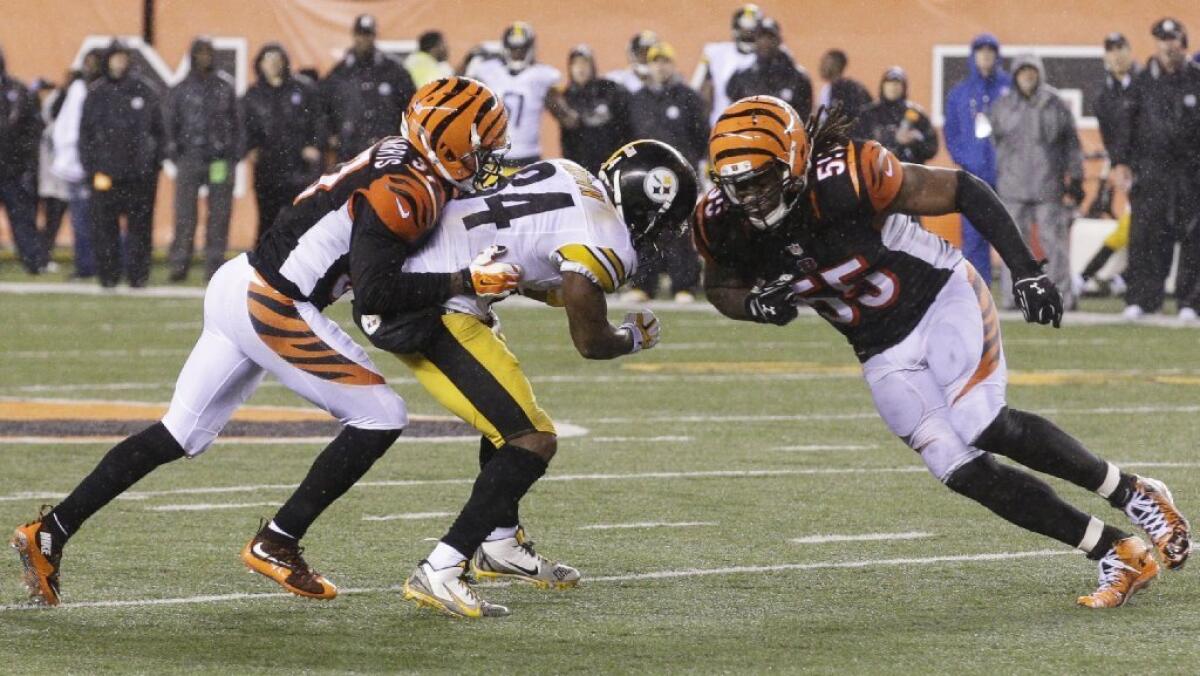A small study of retired NFL players finds big evidence of head trauma

The Cincinnati Bengals’ Vontaze Burfict (55) runs into the Pittsburgh Steelers’ Antonio Brown (84) during an NFL wildcard game in January. Burfict was penalized on the play. A new study finds evidence that brain trauma could be widespread among former NFL players.
- Share via
A study of the brains of 40 retired National Football League players has found evidence that damage and impairment is widespread in those who have played the game professionally.
The study is small, but nonetheless one of the largest to examine the brains of former football players athletes while they’re alive. The new research, to be presented Tuesday at the annual meeting of the American Academy of Neurology, looked at the retired players, most off the field for less than five years, with an average age of 36.
See the most-read stories in Science this hour >>
Even among such young retirees, researchers from Florida State University’s School of Medicine found that 43%, or 17 of the former players, had structural abnormalities in the connective tissue of their brains — the white matter that speeds signals among cells — that is considered reliable evidence of traumatic brain injury. Brain scans performed with Magnetic Resonance Imaging (MRI) showed that 30%, or 12, had disruption of the nerve axons — the protuberances that extend from one brain cell to another to transmit electrical impulses — consistent with brain injury.
And in tests of cognitive performance, roughly half of the former players showed significant problems of executive function — a global measure of a person’s ability to maintain attention, plan and organize. Specifically, 45% had measurable problems with learning and memory, 42% had problems with attention and concentration, and 24% had problems with spatial and perceptual function.
The retired players who participated in the study ranged in age from 27 to 56, and had played in the NFL anywhere from two to 17 years. (The average was seven years.) The study’s lead author, Florida State’s Dr. Francis X. Conidi, called it “one of the largest studies to date in living retired NFL players and one of the first to demonstrate significant objective evidence for traumatic brain injury in these former players.”
There was no control group, which would give experts a clear basis for comparison among similar-aged men who had not engaged in contact sports. And it was not clear how the study’s participants were recruited, and whether they had sought treatment for neurological problems in advance of their recruitment into the study. Those factors, in addition to the study’s relatively small size, make it difficult to drawer larger conclusions about how widespread brain abnormalities would be in a random pool of former players.
But the new study makes progress toward an important aim: to be able to recognize concussion-related damage while a patient is still alive — and possibly before behavioral symptoms of that damage have reached a crisis point. Research conducted on former contact-sport athletes had focused heavily on post-mortem brain examinations of individuals who died after lengthy careers and, often, after suffering severe symptoms of depression, aggression, memory loss and other problems of cognition and movement.
“This research in living players sheds light on the possible pathological changes consistent with chronic traumatic encephalopathy that may be taking place,” said Conidi, of the Florida Center for Headache and Sports Neurology and Florida State University’s College of Medicine in Tallahassee.
The 40 former players reported an average of 8.1 concussions, and 12 players (31%), said they had sustained several sub-concussive hits — blows to the head considered below the diagnostic threshold for concussion.
The newest research, however, does not clarify how best to predict cognitive impairment in former players, or whether worse damage is done by actual concussions or the accumulation of smaller blows. Evidence of brain injury on the advanced MRI scan scaled upward with longer NFL careers. But on the traditional MRI, there was no relationship between the number of years a player spent in the NFL and whether he had signs of brain damage.
The researchers also found no clear relationship between the number of concussions a player had and whether that advanced MRI showed him to have traumatic brain injury.
Follow me on Twitter @LATMelissaHealy and “like” Los Angeles Times Science & Health on Facebook.







